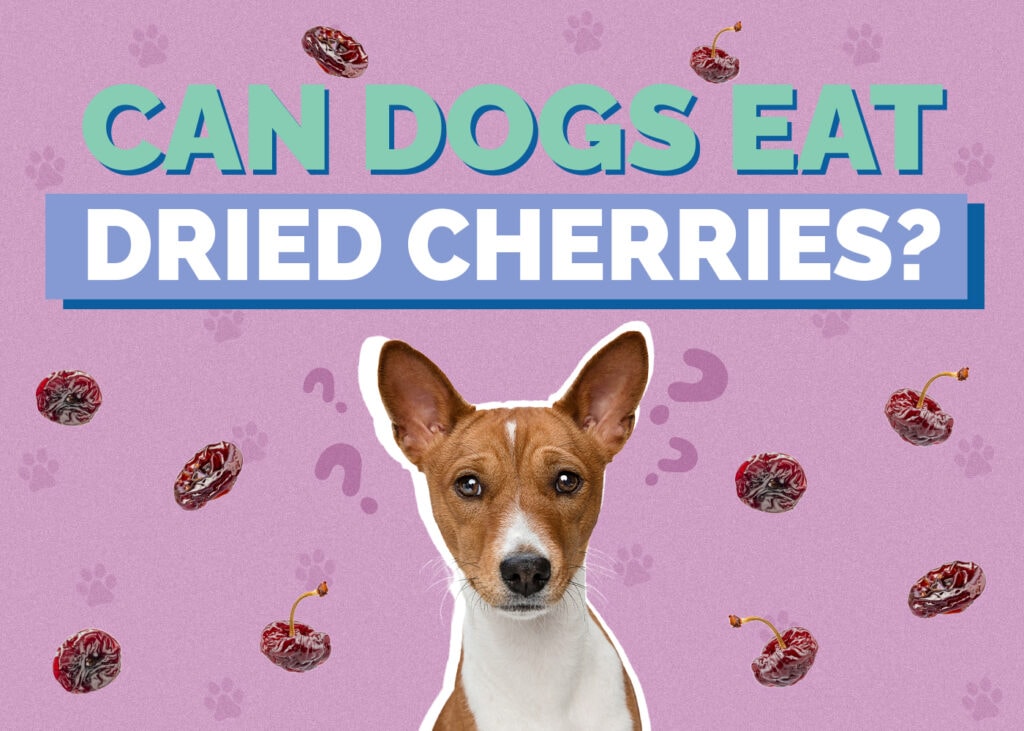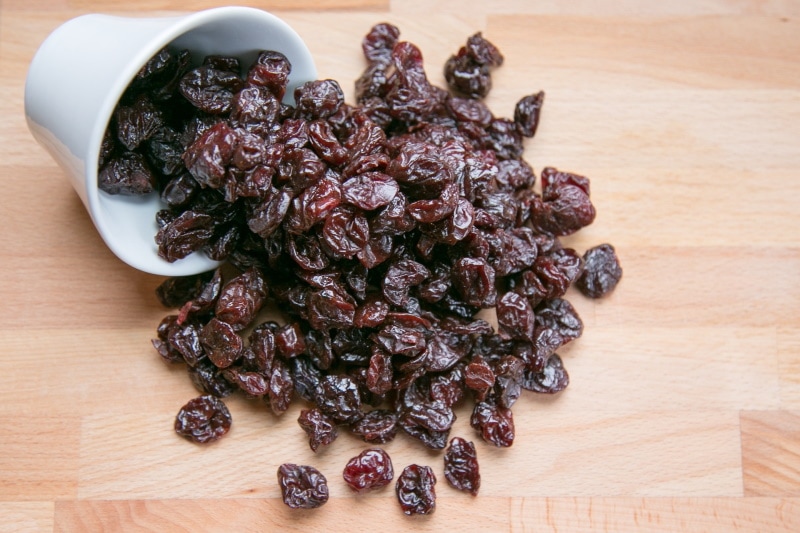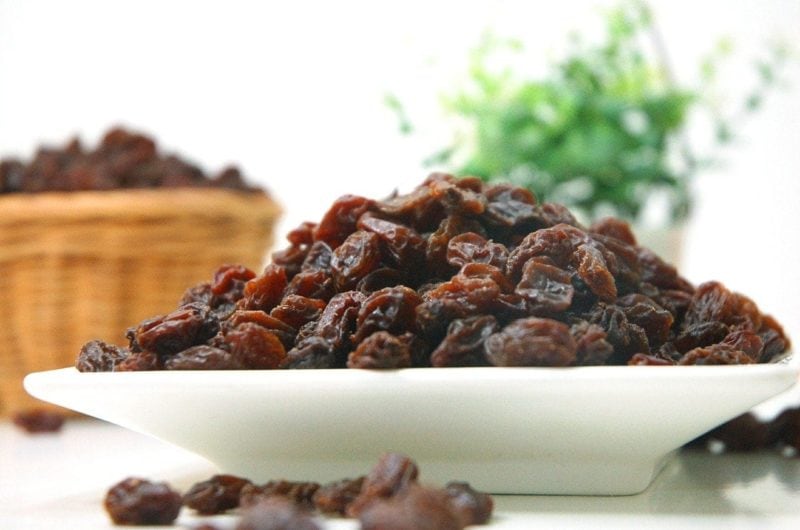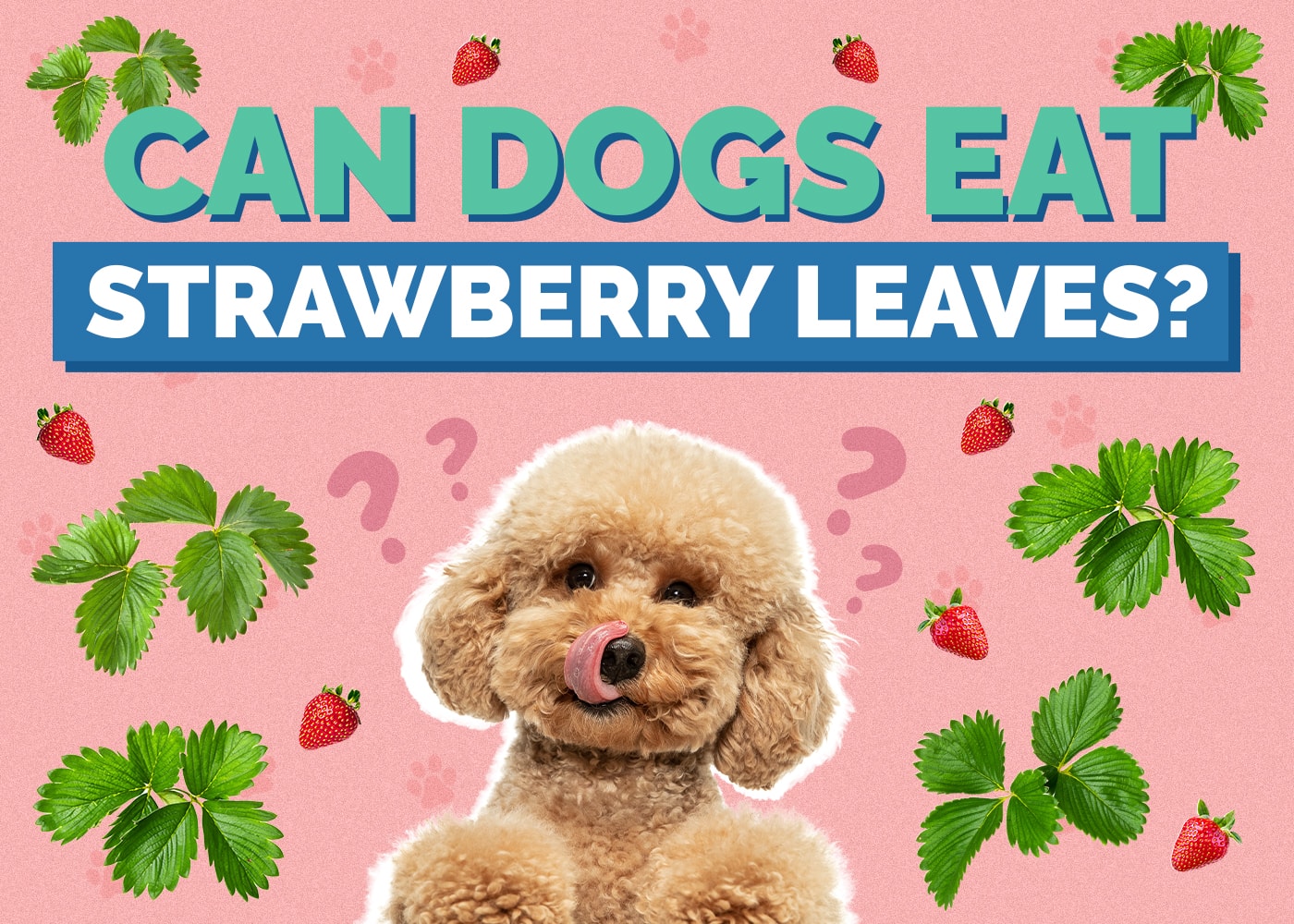Can Dogs Eat Dried Cherries? Safety & Toxicity Information

Updated on

Dogs are known for being loyal and loving companions, and we often want to share our favorite treats with them. However, it’s important to remember that not all human foods are suitable for dogs to eat. Dried cherries are a tasty snack for humans, but is it appropriate for dogs to eat them too?
The answer is that yes, dogs can safely eat dried cherries in moderation. This is true if—as is most often the case—the dried cherries in question are without leaves, pits, or stems, which can be harmful to dogs. So, while it may seem like an innocent treat to share with your dog, there are some important issues to consider before you give them a dried cherry. Before you give your dog new food, especially processed human food, you should always consult your veterinarian first. What might work for one dog might not work for another, based on factors such as their age, health history, conditions, and diet.
In this article, we’ll explore the potential risks and benefits of feeding dried cherries to dogs and provide some recommendations for those who are considering giving them to their furry friends.
What’s in Most Dried Cherries?

Most commercially dried cherries have all been pitted and consist of just the fleshy part of the cherry with the moisture removed. As a result, the skin thickens, which protects them from decay, and makes them more nutrient-dense. In addition to being easier to store, dried cherries are more lasting and durable, making them ideal for long hikes or snacking on the go. The dried flesh consists mainly of carbohydrates with a small amount of fiber and a lot of sugar.
Any issues that dried cherries pose to dogs do not come directly from the nutritional content of the fruit. Dried cherries contain high concentrations of antioxidants and vitamins—both things that we consider to be good in a human diet—but you shouldn’t be using dried cherries as a health food for your dog.
High Sugar Content
Properly formulated dog foods are where your canine companion should be getting all the nutrition they need, not from sugary treats. And that’s where the real problem with dried cherries for dogs lies: the high sugar content. In other words, small quantities are generally okay, but if you let your dog eat a whole bag of dried cherries, they will be consuming far too much sugar. It is possible for your dog to suffer from an upset stomach as a result of eating too much sugar. Sugar can also be detrimental to your dog’s health over time, leading to health problems such as diabetes, inflammation, and a host of other problems, including hip and joint problems as well as obesity.
Like most things in life, moderation is key. If your dog already has health issues, such as diabetes, then you definitely should not be giving them sugary snacks, and that includes dried cherries.
Hidden Xylitol

It’s also worth reading the package, as although it may say ‘Dried Cherries’ on the front, it might include xylitol on the back. This sugar substitute, which is increasingly being used in commercial products, can be fatal if ingested by dogs and other animals. Xylitol is often found in sugar-free food options such as chewing gum and baked goods. Unfortunately, it can also be hidden within dried fruit such as cherries. If a dog consumes these treated cherries, it could lead to severe hypoglycemia that can cause seizures or liver damage.
Dog owners need to check labels carefully and remain vigilant when shopping for pet-friendly treats or even just grocery items that may contain xylitol.
What About Leaves, Pits, and Stems?
It is important to know that the pit, stem, and leaves of cherries all contain cyanide. Organic compounds of cyanide are found naturally occurring in many other plants, such as almonds, apricots, lima beans, and bamboo shoots; however, the levels of these compounds are generally too low to cause any serious harm.
Theoretically, dogs can be poisoned by ingesting the cyanide found in the leaves, pit, and stems of cherries. Keep in mind that the amount of cherry plant matter that is required to be harmful to a dog depends on the size of the dog, as well as whether the dog chewed on the pits, leaves, or stems or just swallowed them whole. This is because, during chewing, the cyanide in the plant material is released.
Cherries can also pose a choking hazard because of their leaves, pits, and stems. But remember, commercially dried cherries rarely contain the leaves, pit, or stems of cherries.
What Are the Symptoms of Cyanide Poisoning in Dogs?

Cyanide poisoning is rare in dogs but can be rapidly fatal. Pet owners need to recognize the signs and symptoms of cyanide poisoning so that they are able to seek immediate medical attention for their beloved dog. Knowing the symptoms of cyanide poisoning can help pet owners better understand what their dog may be going through and how to treat it.
The most common symptom of cyanide poisoning in dogs is difficulty breathing. This occurs because the poison interferes with the body’s ability to process oxygen, causing oxygen levels in the blood to drop significantly. Other signs that may indicate your dog has been poisoned by cyanide include drooling, vomiting, shock, muscle twitching, confusion, and loss of consciousness. The signs can begin within 20 minutes of ingestion of cyanide and death within 30 minutes of symptoms starting.
What Should I Do if I Suspect My Dog Has Cyanide Poisoning?
Cyanide poisoning is an extremely serious medical condition that can be fatal if not treated quickly. If you suspect your dog may have been exposed to or ingested cyanide, it is important to act quickly in order to help save their life. If you believe your dog has been poisoned with cyanide, contact a veterinarian immediately, as time is critical for successful treatment. Your vet will likely perform tests, including bloodwork and imaging, for diagnosis and will provide supportive care such as oxygen therapy and IV fluids to help flush the toxin from your pet’s system. Again, it’s worth bearing in mind that this is hardly likely to occur if your dog has eaten a couple of pitted, commercially dried cherries. Cyanide toxicity is more common in dogs that have had access to certain rat poisons, fertilizers or eucalyptus plants.
What Dried Fruits are Toxic to Dogs?

It is important to keep in mind that there are some types of dried fruit that are toxic to dogs and should be avoided. Dried fruits may be a convenient and nutritious snack for humans, but they can be dangerous for dogs. Depending on the type of fruit, even small amounts can cause mild to severe symptoms in dogs, such as vomiting and diarrhea, or lead to more serious health complications like organ failure. In some cases, eating too much dried fruit can even prove fatal.
Common toxic dried fruits include raisins, currants, and sultanas—all derived from grapes—all of which are commonly used in popular snacks like granola bars and trail mix. It’s critical to note that all types of grapes—fresh or dried—can be harmful to dogs, even in small amounts.
What Fruits Are Safe for Dogs to Eat?
Fruit should only be given to dogs in moderation, as it is high in sugar and can contribute to weight gain. It’s also a wise idea to check with your veterinarian before introducing any new foods to your dog’s diet. It is important to note that not all fruits are created equal when it comes to safety for your pet. Some may contain toxins or other substances that can be dangerous if ingested by a dog, so it’s best to stick with the following varieties: apples, blueberries, bananas, cantaloupe, honeydew melon, cranberries, and watermelon. All of these fruits provide essential vitamins and minerals that help keep your pup healthy.
Conclusion
In conclusion, dried cherries are generally not toxic to dogs, but they could still pose health risks if consumed in excess. Since dried cherries contain a high level of sugar and can cause digestive issues and other health problems, it is best to avoid feeding them as a regular treat. In addition, it’s important to check the ingredients as there may be other dangerous additives—such as xylitol—in play. To ensure your dog’s safety and health, always consult with your veterinarian before introducing any new food item into your pet’s diet.
See Also:
- Can Dogs Eat Bamboo Shoots? How Healthy Is It?
- Can Dogs Eat Maraschino Cherries? How Healthy Are They?
Featured Image Credit: Olena Rudo, Shutterstock











